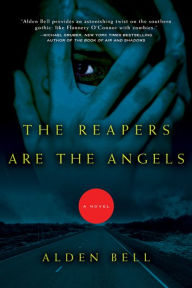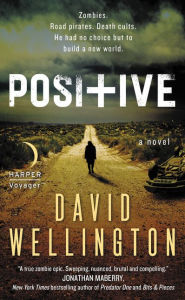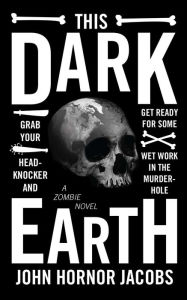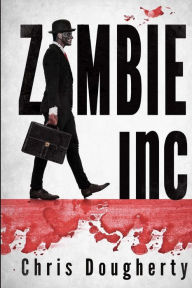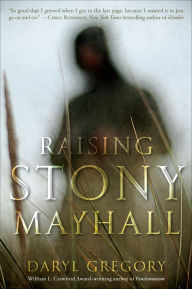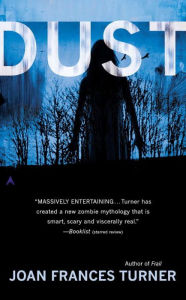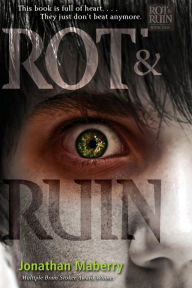9 Novels About Growing up in the Zombie Apocalypse
 I have always been intrigued with characters matriculating in the midst of an apocalypse. They often grow up with very different ethical and social senses than their parents (or other adults acting in loco parentis), which can be a very real source of conflict. The differences between the boy Carl of the comic version of The Walking Dead and the television adaptation are myriad, but the most telling is how brutally expedient the Carl of the comics is. He almost protects his father, Rick, from having to make decisions that would violate his now almost antique notions of justice and societal order. The Carl of the comics is a child of the undead world: quick to make hard choices, and not too fussed about them after the fact. He’d prefer not to get yelled at by Rick, but he’s also going to do what needs doing. If he gets sent to his room then, shrug, at least that sociopathic child didn’t murder them all in their beds while Rick and the other grownups dithered.
I have always been intrigued with characters matriculating in the midst of an apocalypse. They often grow up with very different ethical and social senses than their parents (or other adults acting in loco parentis), which can be a very real source of conflict. The differences between the boy Carl of the comic version of The Walking Dead and the television adaptation are myriad, but the most telling is how brutally expedient the Carl of the comics is. He almost protects his father, Rick, from having to make decisions that would violate his now almost antique notions of justice and societal order. The Carl of the comics is a child of the undead world: quick to make hard choices, and not too fussed about them after the fact. He’d prefer not to get yelled at by Rick, but he’s also going to do what needs doing. If he gets sent to his room then, shrug, at least that sociopathic child didn’t murder them all in their beds while Rick and the other grownups dithered.
In any society, even in times of stability, there’s bound to be a generation gap—but that gap gets so much larger at the end of everything, and so much more brutal in a world where one must kill the undead to survive. The hoary old question of zombie literature is: how will we maintain our humanity in the face of endless violence and brutality? I poke fun, but it’s a valid question, and one that begets another: how does a child raised in a world where they must regularly cave in the skulls of other (admittedly undead) humans prioritize anything other than violent expediency? How does the second generation, who knows nothing of soft beds and cellphones, order their world?
Here are nine takes on children growing up in a zombified world.
The Reapers Are the Angels: A Novel
The Reapers Are the Angels: A Novel
By Alden Bell
In Stock Online
Paperback $21.99
The Reapers are the Angels, by Alden Bell
Temple is about five when the zombie apocalypse starts, and 15 at the start at the novel, working her way through a ravaged American South. She’s almost easier with the dead than the living; at least the dead have simple motivations. She ends up in conflict with Moses Todd, running from his pre-apocalyptic sense of honor. She’s murdered his brother for being a bad man (and he really is). Though Todd knows his brother’s ignominy, due to his pre-apocalyptic moral code, he must chase her just the same. The Reapers are the Angels owes a lot to the Southern Gothic, the pragmatic daughters of dirt farmers doing what needs done in a world where their elders can’t accept reality. It goes like one would expect. Which is to say: not well, but memorably.
The Reapers are the Angels, by Alden Bell
Temple is about five when the zombie apocalypse starts, and 15 at the start at the novel, working her way through a ravaged American South. She’s almost easier with the dead than the living; at least the dead have simple motivations. She ends up in conflict with Moses Todd, running from his pre-apocalyptic sense of honor. She’s murdered his brother for being a bad man (and he really is). Though Todd knows his brother’s ignominy, due to his pre-apocalyptic moral code, he must chase her just the same. The Reapers are the Angels owes a lot to the Southern Gothic, the pragmatic daughters of dirt farmers doing what needs done in a world where their elders can’t accept reality. It goes like one would expect. Which is to say: not well, but memorably.
Positive: A Novel
Positive: A Novel
In Stock Online
Paperback $9.99
Positive, by David Wellington
Almost 20-year-old Finn has been raised in the almost cushy confines of Manhattan Island in the decades after the zombie apocalypse. There’s maybe 20,000 on the island, living on the scraps of a dead civilization. Finn is turned out into the harsh wider world when his mom turns undead right at the end of her possible incubation period: 20 years, just a couple of months past his birth. He’s a positive. Due to his upbringing, he’s almost dangerously naïve. But due to his naïveté, he’s also strictly honorable in a way that seems to have died outside his island home. Finn falls into and out of several post-apocalyptic societies in his picaresque across the American continent, ending in a last stand against religiously minded autocrats. You know, the usual American tale.
Positive, by David Wellington
Almost 20-year-old Finn has been raised in the almost cushy confines of Manhattan Island in the decades after the zombie apocalypse. There’s maybe 20,000 on the island, living on the scraps of a dead civilization. Finn is turned out into the harsh wider world when his mom turns undead right at the end of her possible incubation period: 20 years, just a couple of months past his birth. He’s a positive. Due to his upbringing, he’s almost dangerously naïve. But due to his naïveté, he’s also strictly honorable in a way that seems to have died outside his island home. Finn falls into and out of several post-apocalyptic societies in his picaresque across the American continent, ending in a last stand against religiously minded autocrats. You know, the usual American tale.
This Dark Earth
This Dark Earth
Paperback $21.99
This Dark Earth, by John Hornor Jacobs
Speaking of Southern Gothic (we were, right?), This Dark Earth is a beautiful expression of both the Southern Gothic and the apocalyptic novel, which then bleeds into the post-apocalyptic novel. It is a novel in tight point-of-view sections: beginning in a hospital, with a doctor slowly coming to realize the disaster happening around her, then passing down the road to her lover, her friends, her son. Her son is the Prince of this narrative, the boy raised in this this new, feral world: the heir apparent. He comes into conflict with old school gangsters and gang lords who cannot begin to comprehend the moral necessities of this new world. Like The Reapers Are the Angels, This Dark Earth runs the societal observation and the moral heartbeat on tight tracks together, right through the ruined and fecund landscape of the American South.
This Dark Earth, by John Hornor Jacobs
Speaking of Southern Gothic (we were, right?), This Dark Earth is a beautiful expression of both the Southern Gothic and the apocalyptic novel, which then bleeds into the post-apocalyptic novel. It is a novel in tight point-of-view sections: beginning in a hospital, with a doctor slowly coming to realize the disaster happening around her, then passing down the road to her lover, her friends, her son. Her son is the Prince of this narrative, the boy raised in this this new, feral world: the heir apparent. He comes into conflict with old school gangsters and gang lords who cannot begin to comprehend the moral necessities of this new world. Like The Reapers Are the Angels, This Dark Earth runs the societal observation and the moral heartbeat on tight tracks together, right through the ruined and fecund landscape of the American South.
Zombie Inc.
Zombie Inc.
Paperback $12.95
Zombie, Inc., by Chris Dougherty
It’s 25 years after the zombie apocalypse, and most of humanity in concentrated in company towns, completely insulated from the threats outside the razor wire. Zombie, Inc. has probably the most explicit generational conflict going, with neophyte Dil beginning to apprentice with the hardened alcoholic Carl as its opening action. Dil is insulated and nearly helpless, a harsh contrast with many of the children on this list. The older generation has wrapped the younger in cottonwool, and is using the younger generation’s own youth against it, like you do. The older generation has built society against its next one, holding onto power in ways that are both stupid and greedy. May I interest you in an op-ed about millennials?
Zombie, Inc., by Chris Dougherty
It’s 25 years after the zombie apocalypse, and most of humanity in concentrated in company towns, completely insulated from the threats outside the razor wire. Zombie, Inc. has probably the most explicit generational conflict going, with neophyte Dil beginning to apprentice with the hardened alcoholic Carl as its opening action. Dil is insulated and nearly helpless, a harsh contrast with many of the children on this list. The older generation has wrapped the younger in cottonwool, and is using the younger generation’s own youth against it, like you do. The older generation has built society against its next one, holding onto power in ways that are both stupid and greedy. May I interest you in an op-ed about millennials?
The Boy on the Bridge
The Boy on the Bridge
By M. R. Carey
Hardcover $26.00
The Boy on the Bridge, by M.R. Carey
Five-year-old Stephen Greaves was found, ten years ago, by epidemiologist Samrina Khan, under the bodies of his dead parents who were killed, one would hope, before the cordyceps fungus could render them into unthinking hungries. Ten years later, Stephen and Rina are two of a dozen-odd members of a scientific mission aboard the Rosalind Franklin, a mobile tank-slash-scientific research center rolling its way through the ruined English countryside. Stephen is a child, of sorts; he’s only 15 years old. In a normal world, Stephen would be diagnosed as on the autistic spectrum, but in this rough and brutal situation, it’s hard to separate the trauma of his childhood from any neat psychological diagnosis. For the most part, the adults aboard the Rosie resent and discount both his upbringing and his unique perspective. Though they don’t much credit him, Stephen is much more capable of navigating this rough, apocalyptic landscape, much more willing to take it as it is, and not what he has decided it should be.
The Boy on the Bridge is a sidequel to Carey’s The Girl With All the Gifts, another novel which features a child-protagonist living at the end of the world. The difference being that Melanie of The Girl With All the Gifts is a hungry herself, and also so much more. Melanie and Stephen offer very cool and very different takes on growing up in the zombie apocalypse, one on either side of the bridge between the living and the dead.
The Boy on the Bridge, by M.R. Carey
Five-year-old Stephen Greaves was found, ten years ago, by epidemiologist Samrina Khan, under the bodies of his dead parents who were killed, one would hope, before the cordyceps fungus could render them into unthinking hungries. Ten years later, Stephen and Rina are two of a dozen-odd members of a scientific mission aboard the Rosalind Franklin, a mobile tank-slash-scientific research center rolling its way through the ruined English countryside. Stephen is a child, of sorts; he’s only 15 years old. In a normal world, Stephen would be diagnosed as on the autistic spectrum, but in this rough and brutal situation, it’s hard to separate the trauma of his childhood from any neat psychological diagnosis. For the most part, the adults aboard the Rosie resent and discount both his upbringing and his unique perspective. Though they don’t much credit him, Stephen is much more capable of navigating this rough, apocalyptic landscape, much more willing to take it as it is, and not what he has decided it should be.
The Boy on the Bridge is a sidequel to Carey’s The Girl With All the Gifts, another novel which features a child-protagonist living at the end of the world. The difference being that Melanie of The Girl With All the Gifts is a hungry herself, and also so much more. Melanie and Stephen offer very cool and very different takes on growing up in the zombie apocalypse, one on either side of the bridge between the living and the dead.
Raising Stony Mayhall
Raising Stony Mayhall
In Stock Online
Paperback $20.00
Raising Stony Mayhall, by Daryl Gregory
Raising Stony Mayhall also features a child growing up after the first outbreak of the undead. Stony is found on the side of the road in rural Iowa, an undead babe next to his dead mother. His adoptive family seeks to shield him from a world in which Romero’s Night of the Living Dead is a documentary of the first uprising, and the undead are put down mercilessly. In this world, after the biting savagery of the first turn, a zombie settles down to something similar to his or her former, living personality. Stony has a bucolic childhood, until he must venture forth into the less easy world of undead politics and the fear of the living. As one of the undead, he must hide from the living (other than his confidantes and family) lest he be murdered out of house. Stony spends a lot of time ruminating on the differences between the living and undead, cut off as he is from society at large. This is the most metaphysical zombie novel I’ve ever encountered, and I mean that in a good way.
Raising Stony Mayhall, by Daryl Gregory
Raising Stony Mayhall also features a child growing up after the first outbreak of the undead. Stony is found on the side of the road in rural Iowa, an undead babe next to his dead mother. His adoptive family seeks to shield him from a world in which Romero’s Night of the Living Dead is a documentary of the first uprising, and the undead are put down mercilessly. In this world, after the biting savagery of the first turn, a zombie settles down to something similar to his or her former, living personality. Stony has a bucolic childhood, until he must venture forth into the less easy world of undead politics and the fear of the living. As one of the undead, he must hide from the living (other than his confidantes and family) lest he be murdered out of house. Stony spends a lot of time ruminating on the differences between the living and undead, cut off as he is from society at large. This is the most metaphysical zombie novel I’ve ever encountered, and I mean that in a good way.
Dust
Dust
Paperback $7.99
Dust, by Joan Frances Turner
Another novel about someone matriculating in the zombie apocalypse, but this time, it’s a zombie. Nine years before, 15-year-old Jessie’s father took an ill-advised detour into the wilds of the Midwest, where gangs of the undead roamed; she ended up zombified. After crawling her way out of the grave, she ends up part of the Fly-by-Nights, who shamble through the rural wastelands between hoo (human) outposts, preying on animals. An illness that strikes both the living and the undead upends Jessie’s world, putting pressure on her allegiances: all the dead were once living, just as all the old were once young. Dust is a strange, dancing take on the corruption and devolution of the zombie apocalypse, seen from outside the walled gates.
Dust, by Joan Frances Turner
Another novel about someone matriculating in the zombie apocalypse, but this time, it’s a zombie. Nine years before, 15-year-old Jessie’s father took an ill-advised detour into the wilds of the Midwest, where gangs of the undead roamed; she ended up zombified. After crawling her way out of the grave, she ends up part of the Fly-by-Nights, who shamble through the rural wastelands between hoo (human) outposts, preying on animals. An illness that strikes both the living and the undead upends Jessie’s world, putting pressure on her allegiances: all the dead were once living, just as all the old were once young. Dust is a strange, dancing take on the corruption and devolution of the zombie apocalypse, seen from outside the walled gates.
Rot & Ruin (Rot & Ruin Series #1)
Rot & Ruin (Rot & Ruin Series #1)
In Stock Online
Paperback $13.99
Rot & Ruin, by Jonathan Maberry
When Benny Imura turns 15 at the start of this novel, he must find a job or have his rations cut in half. He begins to apprentice with his much older brother Tom, who goes out into the zombie wasteland, past the razor wire, to find undead relatives and give them “closure” (aka crush their skulls.) Older brother Tom may not be a parent, but he’s a parental figure. He has a calm understanding of his post-apocalyptic world that the twitchy, adorably naïve Benny should (and ultimately does) aspire to, even while he occasionally rails against what he sees as Tom’s high-handedness. Benny leaves the careful cocoon of his upbringing and learns that the world is larger, and morally grayer, than in the easy expediency of childhood, where the dead are dead and the living are living.
Rot & Ruin, by Jonathan Maberry
When Benny Imura turns 15 at the start of this novel, he must find a job or have his rations cut in half. He begins to apprentice with his much older brother Tom, who goes out into the zombie wasteland, past the razor wire, to find undead relatives and give them “closure” (aka crush their skulls.) Older brother Tom may not be a parent, but he’s a parental figure. He has a calm understanding of his post-apocalyptic world that the twitchy, adorably naïve Benny should (and ultimately does) aspire to, even while he occasionally rails against what he sees as Tom’s high-handedness. Benny leaves the careful cocoon of his upbringing and learns that the world is larger, and morally grayer, than in the easy expediency of childhood, where the dead are dead and the living are living.
The Forest of Hands and Teeth (Forest of Hands and Teeth Series #1)
The Forest of Hands and Teeth (Forest of Hands and Teeth Series #1)
By Carrie Ryan
In Stock Online
Paperback $12.99
The Forest of Hands and Teeth, by Carrie Ryan
Of all of these books, I think The Forest of Hands and Teeth is set furthest from the zombie apocalypse, long enough for a religious autocracy to set up a human society behind rusting chainlink fences. We’re at least three generations in at the start. Mary is an unlikeable young woman who must either marry or become a member of the Sisterhood once she reaches a certain age. There’s some dithering with love triangles until everything about her world is breached and destroyed, sending her on a quest to find the mythical ocean. This one is an interesting character study, because I was never quite sure whether I was supposed to love Mary or hate her. She’s definitely selfish and self-serving, but maybe those are laudable characteristics in the world she inhabits? Where Rot & Ruin is clear about its moral architecture, The Forest of Hands and Teeth is hazier, more dependent on the reader’s specific take.
What’s your favorite post-apocalyptic bildungsroman?
The Forest of Hands and Teeth, by Carrie Ryan
Of all of these books, I think The Forest of Hands and Teeth is set furthest from the zombie apocalypse, long enough for a religious autocracy to set up a human society behind rusting chainlink fences. We’re at least three generations in at the start. Mary is an unlikeable young woman who must either marry or become a member of the Sisterhood once she reaches a certain age. There’s some dithering with love triangles until everything about her world is breached and destroyed, sending her on a quest to find the mythical ocean. This one is an interesting character study, because I was never quite sure whether I was supposed to love Mary or hate her. She’s definitely selfish and self-serving, but maybe those are laudable characteristics in the world she inhabits? Where Rot & Ruin is clear about its moral architecture, The Forest of Hands and Teeth is hazier, more dependent on the reader’s specific take.
What’s your favorite post-apocalyptic bildungsroman?
